|
Venice > Planning > Venice for Dogs
Venice is a dog-friendly city, and your pet is
welcome if you know the ropes and follow the rules.
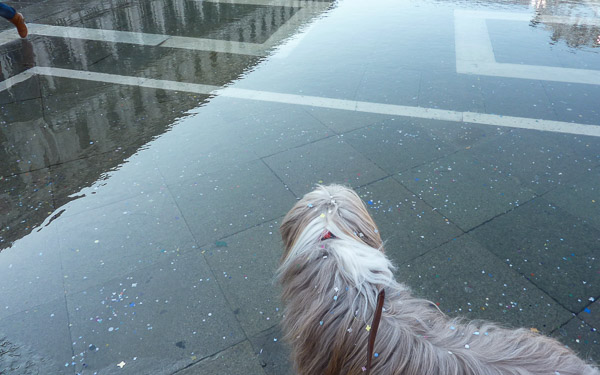
ABOVE: Maggie the Bearded Collie watches as water
bubbles up from a drain in Venice's Piazza San Marco during high tide.
by
Durant Imboden
There was a time when Venice was known for its
feral cats, but today, pet dogs have largely displaced their feline rivals. And
canine residenti aren't the only dogs in town--the city also hosts
visiting cani in droves.
Your dog is welcome to join the local canine community, as long as
it's well-behaved and you understand the practicalities of traveling with a
dog in Venice, Italy.
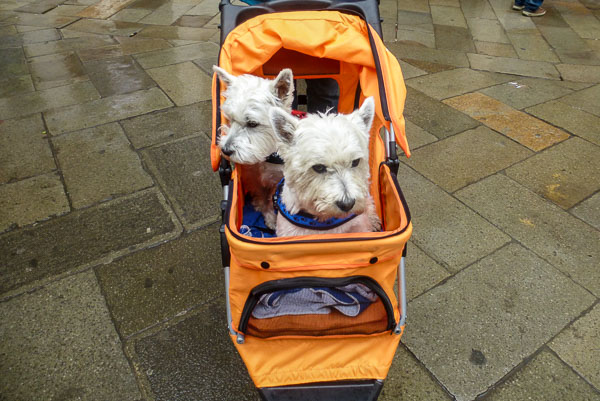
ABOVE: When these dogs need a room, they ask for
a double.
-
We recommend finding a hotel room or
vacation apartment in central
Venice to minimize commuting. (The
Lido di Venezia, Venice's island beach resort, is another
possibility if you don't mind a
ride by water bus
to the city center.)
-
Many hotels
and rentals allow dogs--sometimes for an added fee, sometimes at no extra cost.
-
Our accommodations partner,
Booking.com,
makes it easy to see whether a property is pet-friendly. On Booking's individual
hotel or rental pages, scroll down to "House Rules" for the property's pet
policy.
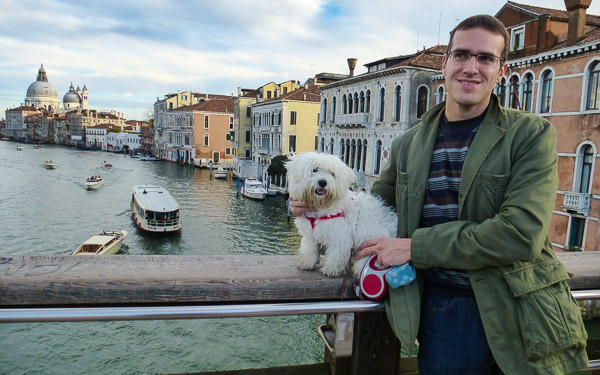
ABOVE: A man and his dog pose on the Accademia Bridge, which
is close to hotels in several price ranges.
Tips:
-
Try to stay at a hotel or apartment that's near your
arrival
and departure point. Hauling luggage over footbridges while trying to
control a dog can be difficult, especially during peak travel months or on
weekends. Squeezing onto a crowded public water bus with suitcases and a dog
isn't much fun, either.
-
A location near a relatively quiet square (or, better yet, a
patch of scruffy grass) will be convenient when your dog needs to relieve
itself. See "Practical advice and warnings" below for more on this topic.
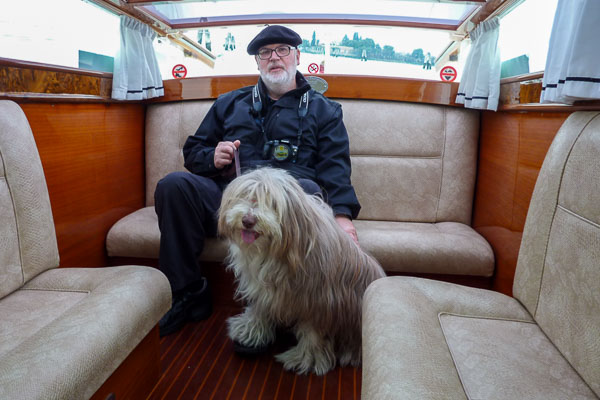
ABOVE: A water taxi can make it easy to get from the
airport or railroad station to central Venice, but getting in and out may be tricky if your
large dog isn't used to boats.
From Venice Marco Polo Airport (VCE):
Airport buses.
ATVO express coaches
and ACTV city buses run between VCE
and the Piazzale Roma, which is Venice's gateway
for motorized traffic. You can bring a dog on both kinds of bus.
On ATVO coaches, the rules are as follows:
-
Well-behaved pets in small cages or carriers travel free,
but you need to hold the carrier in your lap.
-
Medium and large dogs travel at full fare, and they can't
occupy a seat. (Exception: Guide dogs for sight- and hearing-impaired
passengers travel free.)
On ACTV buses, the rules are the same as for public water buses
(vaporetti), as indicated under "Dogs on public transport" below.

ABOVE: An Alilaguna airport boat leaves the
Arsenale waterbus stop while a companion boat points toward the Piazza San Marco.
Alilaguna airport boats.
Alilaguna's distinctive
yellow-and-white water buses connect Venice Marco Polo Airport with the city
center.
Dogs of any size travel free on Alilaguna, but--at least in theory--they must be
muzzled and held in the passengers' arms.
Please note:
-
If an Alilaguna boat is crowded or your dog makes the crew
uncomfortable, the dog may not be allowed on board. (Guide dogs are always
permitted but must be muzzled.)
-
The Alilaguna Blue Line to the Piazza San Marco and beyond
has large boats and is fairly dog-friendly. Boats of the Orange Line (which
runs up the Grand Canal) are smaller and more cramped. If you have a medium
or large dog, take the Blue Line whenever possible.
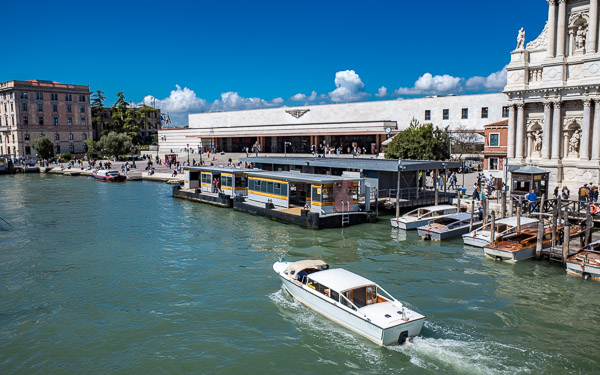
ABOVE: A water taxi approaches the Venezia Santa Lucia
railroad station.
Water taxis.
Dogs are allowed on water taxis
without charge, unless the pilot objects.
Be aware that getting into and out of
a water taxi can be tricky, especially if your dog balks at jumping across the
gap between the boat and the landing point.
(Warning: The water taxi's entrance
steps may be well above or below the level of the boat landing, depending on the
tide.)
Land taxis.
Conventional four-wheeled taxis
run between Venice Marco Polo Airport and the
Piazzale Roma, where you walk to your hotel or board a public water bus
(such as the Line 1 vaporetto),
which runs up the Grand Canal to the Piazza San Marco and beyond.
Small dogs can ride in taxicabs for a modest fee. Some taxi drivers
may allow medium and larger dogs, but a ride isn't guaranteed.
From Treviso Airport (TSF):
TSF is used by Ryanair and Wizzair. Two bus lines, ATVO and
Barzi, run between Treviso Airport and central Venice. See our
Treviso Airport
Buses article for more details.
Note: ATVO's pet-friendly rules are listed under "Airport buses"
above. Barzi doesn't allow animals, except for guide dogs.
From the Venezia Santa Lucia
railroad station:
After leaving the Venice
railroad station in the city center, you can:
-
Walk to your destination;
-
Take a public water bus (see below); or...
-
Pay €60,-- or more to travel by water taxi within
central Venice.
Note: You'll find vaporetti (water buses) and water taxis along
the waterfront in front of the station.

ABOVE: A dog and its companion are parked on a bench in Venice.
From a parking lot or garage:
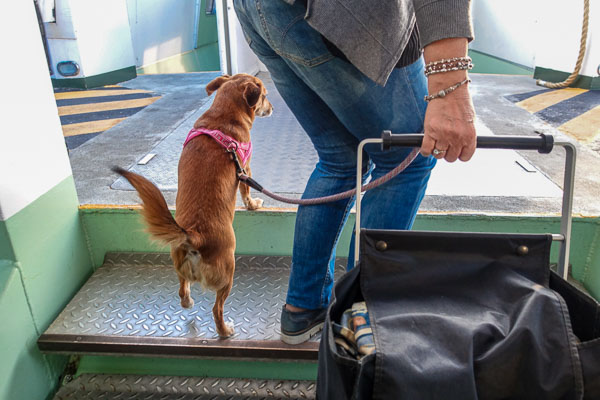
ABOVE: A dog climbs the steps of an ACTV water bus in
Venice.
-
Transportation services within Venice's historic center include
water buses such as vaporetti (operated by ACTV), traghetti
(gondola ferries across the Grand Canal), and gondole (Venice's classic
sightseeing boats where an oarsman stands behind you as the gondola moves gently
through local canals).
-
In addition, ACTV offers buses and trams that serve Venice's
mainland districts of Mestre and Marghera. You can also use ACTV tickets on the
People Mover, an elevated tram that runs from the Piazzale Roma to the Marittima
cruise basin and the Tronchetto parking island.
-
For more about getting around Venice, see our
Local Transportation articles.
Here's what you need to know about ticketing and traveling if you're a dog:
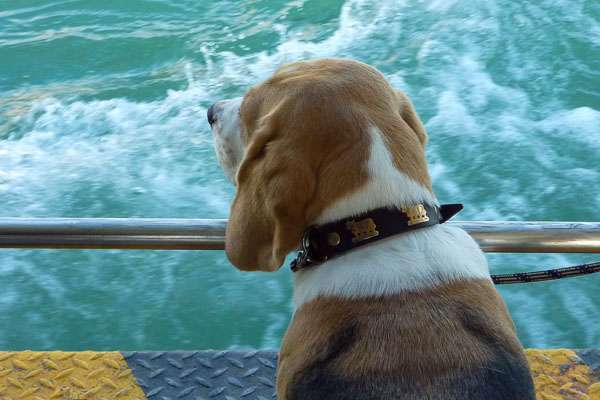
ABOVE: A Beagle enjoys the view from a No. 2 vaporetto
on the Giudecca Canal.
ACTV public transportation:
-
You can bring one dog per passenger on
water buses, land buses,
trams, and the
People Mover. The pet travels free.
Your dog must wear a muzzzle, and it must be leashed or carried.
-
Pet carriers are also allowed, with a maximum size of "150
cm as a sum of the three dimensions."
Please note:
-
Only small dogs are allowed on land buses and
trams. However, this is Italy, and the definition of "small" may be
stretched by a sympathetic driver or ticket inspector.
-
Your dog won't be allowed to board if the boat or vehicle is
too crowded, or if the dog is judged to be a danger to other passengers'
safety.
-
You may notice that local dogs don't always wear leashes and
muzzles on public transportation. In Venice, residenti often get
more favorable treatment than tourists do, so it's best to play it safe and
follow the rules.
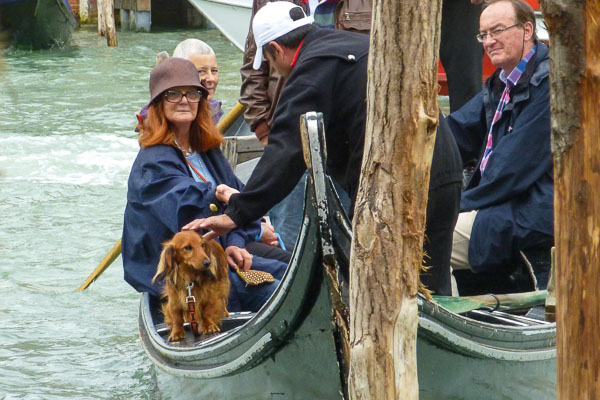
ABOVE: A Dachshund rides a traghetto on the Grand
Canal.
Traghetti (gondola ferries):
-
A traghetto is an oversized gondola (see
Gondole below) that has two oarsmen: one in the bow, and another in the
stern.
-
These human-powered passenger ferries run more or less continuously between landings on
either side of the Grand Canal. The journey is quite short, and the cost is
modest.
-
Depending on the year and season, there may be anywhere from two
or three to half a dozen traghetto routes in operation.
-
Local dogs frequently ride on traghetti, and many of them hop on
and off with great agility. Tourist dogs aren't forbidden, but unless your dog
is small enough to carry in your arms (or is obviously comfortable with small
boats), the boatman may wave you off at the pier.
-
Read our traghetto article for more details and photos.
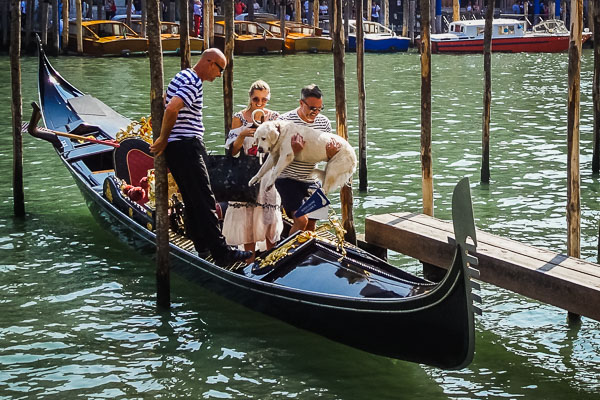
ABOVE: A man helps a dog disembark from a
gondola on the Grand Canal.
Gondole:
-
A gondola is a sightseeing boat, not a form of
point-to-point transportation, but we're featuring gondole here because
a surprising number of gondoliers are willing to take dogs on a leisurely tour
of Venice's canals.
-
For more information on prices and passenger limits, see our
article on Gondolas and gondola rides.
Train travel from the mainland:
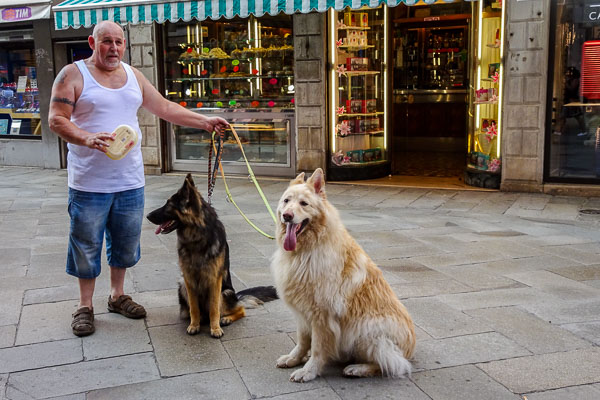
ABOVE: A man poses with his leashed dogs on a Venice
shopping street.
Basic rules and regulations:
-
Dogs should be kept on leashes no longer than 1.5 meters, unless
they're in pet carriers.
-
In theory, a muzzle is required, so it's a good idea to carry
one even if your dog isn't wearing it.
-
Also note that you can't enter Italy with more than five dogs
per person or with puppies younger than 15 weeks.
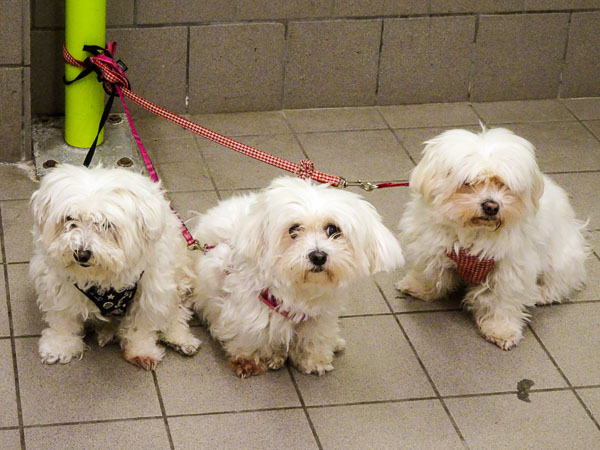
ABOVE: A trio of mini-dogs wait for their owner in the
entrance of a Prix supermarket.
Where dogs are welcome:
-
In general, Venice is a dog-friendly city. Most shops, bars, sidewalk
cafés, etc. allow dogs. So do many indoor restaurants, at least in the
lower price ranges.
-
Supermarkets and other food stores are supposed to be off limits
to dogs, but the rule isn't always enforced. (In supermarkets, you'll often see
dogs waiting for their owners inside store entrances.)
Coping with crowds:
-
If your dog is at all skittish in crowds, we suggest visiting at
a quieter time of year (see Venice in Winter)
or avoiding the area between the Piazza San Marco and the
Rialto Bridge.
-
Small dogs may feel safer and more comfortable in your arms or in a
pet stroller. However, if you're using a stroller, be aware that central Venice
has more than 400 footbridges with steps.
Food and water:
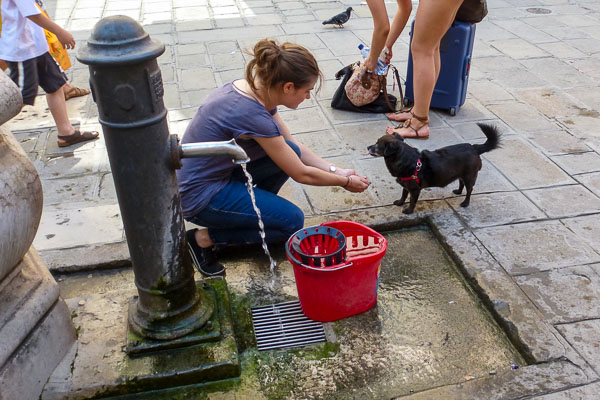
ABOVE: A woman gives her dog a drink at a public
water fountain in Venice.
-
Feeding your dog isn't likely to be a problem: Pet stores are in
nearly every neighborhood, and supermarkets also have dog food and snacks.
-
Water is also easy to find, thanks to free-flowing tap
water at 122 public fountains in the city center.
Often you'll find a dog bowl sitting on the drain, but it's a good idea to carry
a bowl with you. (Or you could just cup your hands, like the woman in the photo
above.)
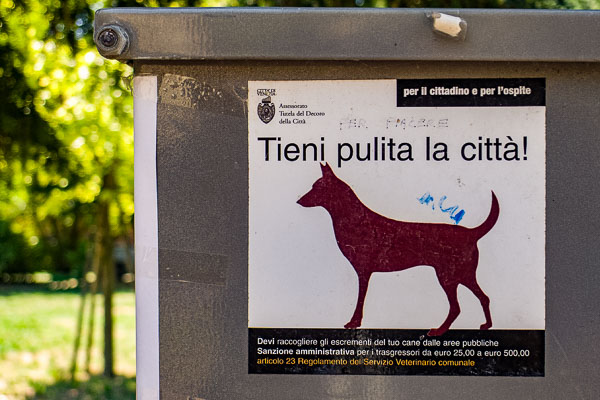
ABOVE: A "Keep our city clean" placard in
the Giardini Pubblici warns dog owners to pick up after their pets. (Fines for
noncompliance range from 25 to 500 euros.)
Pipi and cacca:
-
Most of Venice's grass is behind walls, in private
courtyards. However, dogs are welcome in the city's public parks and
gardens,
and they can do their business as long as you pick up their poop. (See
Parks and Gardens in Venice for
more information.)
-
In addition to official parks, there are a few patches of scruffy grass scattered around
Venice's historic center. Local dog owners often seek out the grass by the
Church of San Trovaso in Dorsoduro, next to the
Squero or gondola boatyard.
Another, albeit less convenient, spot is the
Giardino di Fondamenta de la Pescaria behind iUAV (one of Venice's
universities) and the San Basilio waterfront.
-
In general, your best bet is visit a park, or be patient until your dog
figures out that paving stones are a usable alternative to grass for toileting
purposes.
-
Remember to carry disposal bags when you're walking with
your dog. (Public trash bins can be hard to find, but they do exist, so
don't give up until you find one.)
-
Avoid letting Fido or Fifi let loose in the middle of a busy
street. Look for campi (public squares) that aren't too crowded or
empty back streets where you can clean up after your dog without
inconveniencing pedestrians.
-
Our Maggie hated
going pipi or cacca on unadorned pavement, but she found
the Campo San Polo (Venice's second-largest square) reasonably congenial
because it had sprigs of grass growing between the stones. Keep the Campo
San Polo in mind if your dog insists on at least a hint of vegetation.
-
If you have a male dog, try to keep him from whizzing on
brick or stone buildings. The salts in urine can be destructive to historic
monuments. (Another great idea: We've
seen locals carry water bottles to rinse spots that their male dogs have
targeted.)
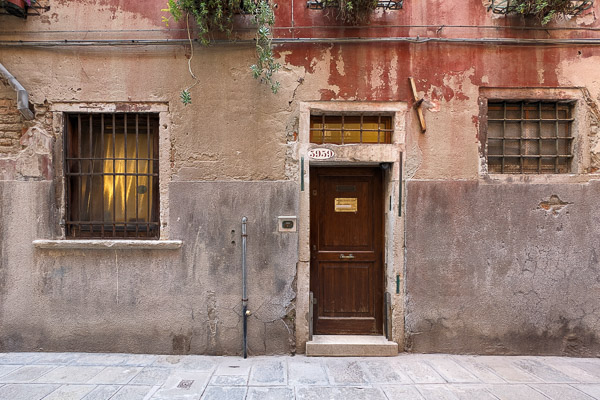
ABOVE: This veterinarian's clinic in the
Cannaregio district is typical of Venice's animal hospitals: It looks like an
ordinary house or apartment, except for the small brass plate on the door.
Veterinarians:
-
If your dog is injured or ill,
go to Veterinby's list of
Venice
animal clinics and scroll down past the ads. (If you're staying on the
Italian mainland, see Veterinby's list of
Mestre
veterinarians instead.)
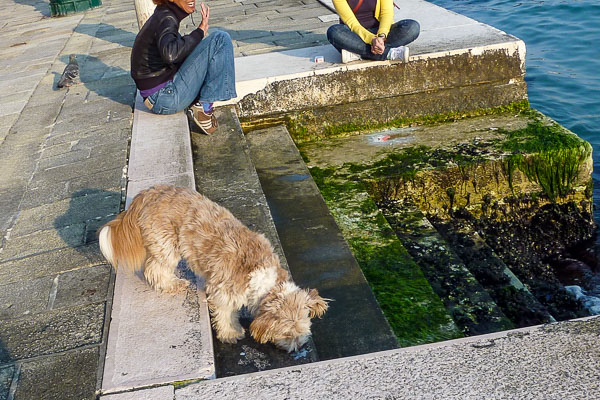
ABOVE: A dog dips its nose in the Giudecca Canal during
a walk along the Zattere promenade in Dorsoduro.
For the activities mentioned in the previous section, the
nearest quiet square or street will do. But when your dog needs a long,
uninterrupted walk without having to bump canine shoulders with fellow tourists,
here are a few suggestions. (We suggest investing in a good printed map or using
Google Maps: Venice on a
large screen.)
San Marco and Castello:
-
Along the way, you'll encounter the
Giardini Pubblici, a large park with benches and trees where you and your
dog can take a break from San Marco's tourist crowds. (This turns into the
Parco delle Rimembranze after you've crossed
into Sant'Elena via a small bridge.)
-
Tip: The
Hotel Indigo Venice -
Sant'Elena is a convenient place to stay if you and your dog want a
quiet hotel near parks and other greenery. The hotel is only a 30-minute
walk from the Piazza San Marco, and a vaporetto stop is close by.
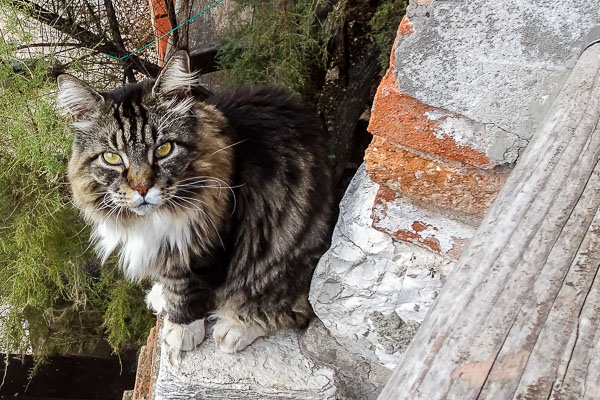
ABOVE: A Maine Coon cat makes a cameo appearance in Cannaregio.
Cannaregio:
-
From the main pedestrian route from the railroad station to the
Piazza San Marco, turn left (north) at the Ponte
delle Guglie and follow the eastern side of the
Cannaregio Canal until you reach an area
of vaguely modern public housing.
-
Head inland and look for a small bridge to the
Fondamenta Carlo Coletti.
-
Continue walking on this long canalside promenade, which
will change names several times. The fondamenta is seldom crowded,
even during the main tourist season, and you can easily wander off it to
explore even quieter parts of the neighborhood to your north.
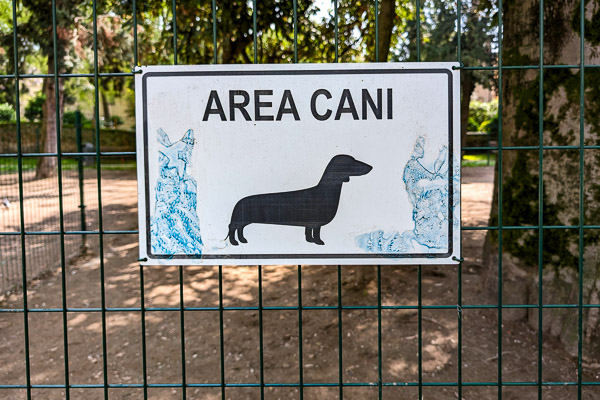
ABOVE: Cannaregio's Parco Savorgnan has a fenced-in dog
area.
-
An even better location (if your dog wants to run free) is the Parco Savorgnan,
which is just off the Rio Terra Lista di Spagna as you head east from the
Venezia Santa Lucia railroad station. The quiet, dog-friendly park is used
mostly by locals, even though it's only one short block from one of Venice's
busiest pedestrian thoroughfares.
Dorsoduro:
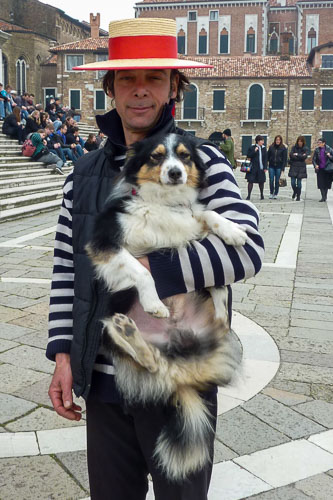
ABOVE: A gondolier shows off his dog near the Basilica
di Santa Maria della Salute in Dorsoduro.
-
Head for the Zattere, a
broad promenade along the Giudecca Canal.
-
Walk to the tip of the Dorsoduro, then continue around the
tip (past the historic Dogana or Customs House) and follow the
obvious walking route until you're back near your starting point.
-
For an even less touristed route (or if you're staying near
the Piazzale Roma), use your tourist map to
reach the peaceful neighborhoods behind the San Basilio cruise terminal.
(The small quarter of Santa Marta is a
neighborhood where tourists hardly ever go.)
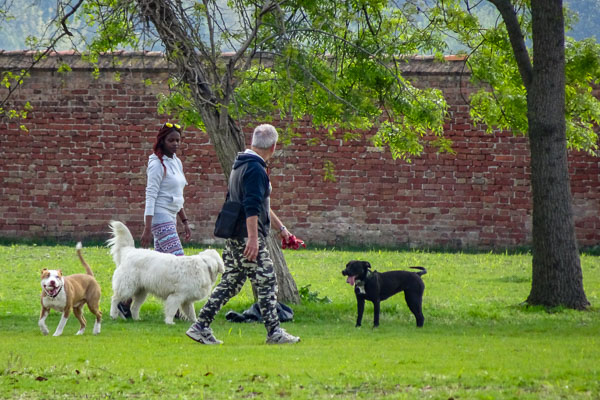
ABOVE: A couple and their dogs enjoy an outing on
the small island of La Certosa, which lies off the eastern tip of central
Venice.
La Certosa:
-
The island of La Certosa is
home to Venice's largest marina. It has plenty of grass, and locals often go
there to let their dogs run free.
-
To reach La Certosa, take the 4.1 or 4.2 waterbus route from
San Pietro di Castello or
Sant'Elena. (The ride is short but
expensive. To save money if you're using the vaporetto frequently, buy a
24-hour to 7-day ACTV tourist pass.)
La Giudecca:
-
This long, narrow island lies across the
Giudecca Canal from Venice's historic
center. It has only a few tourist attractions (such as the Redentore
Church), but it's great for dog-walking because it offers pleasant views of
central Venice without crowds.
-
You can reach La Giudecca from multiple ACTV vaporetto
stations along the Zattere (see our
Dorsoduro itinerary above), and the trip across the Giudecca Canal takes
only a couple of minutes.
Also see:
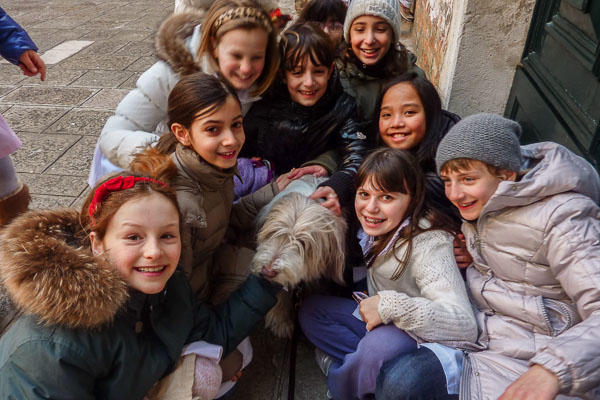
ABOVE: Maggie poses with Venetian schoolgirls in the
Campiello Albrizzi.
Maggie in Venice
Our archived
dog blog about the adventures of an
American Bearded Collie in Venice is worth reading, or at least browsing, if
you're as crazy about canines as we are.
About the author:
 Durant Imboden has
written about Venice, Italy since 1996.
He covered Venice and European travel at About.com for 4-1/2 years before launching
Europe for Visitors (including
Venice for Visitors) with Cheryl
Imboden in 2001. Durant Imboden has
written about Venice, Italy since 1996.
He covered Venice and European travel at About.com for 4-1/2 years before launching
Europe for Visitors (including
Venice for Visitors) with Cheryl
Imboden in 2001.
PC Magazine has called this "the premier visitors'
site for Venice, Italy." Over the years, it has helped more than 30 million
travelers. For more information, see About our site,
our Europe for Visitors
press clippings,
and
our reader testimonials.
| |
|
